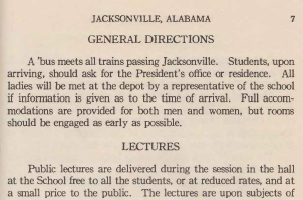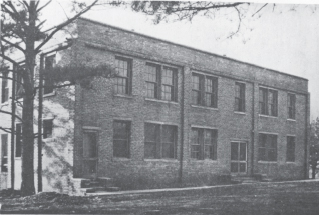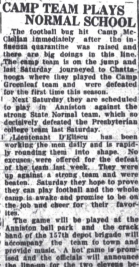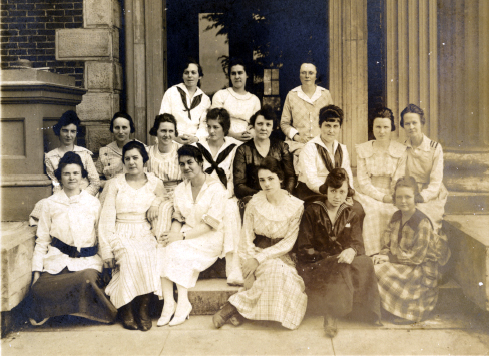Fight On, Fight On for Ole Jax State: HCL's Historical Collections Highlight JSU's Resiliency During Its First Pandemic
09/28/2020

In the uncertainty of the COVID-19 world, those with a pragmatic perspective look for precedent – has anything like this ever happened before and, if so, how did we deal with it? How can the past inform our current situation? The Houston Cole Library’s historical collections offer insight into that most important of questions for an institution of higher education: what did we learn?
 The current pandemic is far from unprecedented. There were major pandemics in 1957-58 and 1968-69. But perhaps the most well-known began in the spring of 1918, when military personnel returning home from World War I brought an H1N1 virus, known as the Spanish Flu, with them. During its worldwide spread in 1918-1919, death estimates put the toll anywhere from 20-50 million people, up to 675,000 in the United States alone. The first cases appeared in Alabama in September 1918, and by the last two weeks of October, 37,000 cases were reported statewide.
The current pandemic is far from unprecedented. There were major pandemics in 1957-58 and 1968-69. But perhaps the most well-known began in the spring of 1918, when military personnel returning home from World War I brought an H1N1 virus, known as the Spanish Flu, with them. During its worldwide spread in 1918-1919, death estimates put the toll anywhere from 20-50 million people, up to 675,000 in the United States alone. The first cases appeared in Alabama in September 1918, and by the last two weeks of October, 37,000 cases were reported statewide.
In attempts to mitigate spread, public health officers in Alabama recommended that public venues be closed. Many primary schools chose to suspend class for up to two weeks, as did some colleges, notably those such as Howard College (now Samford University) located in or near urban areas. Jacksonville State Normal School (now JSU), tucked in the foothills of the Appalachians, did not close its doors.
In addition to a world war and a pandemic, JSNS faced other hardships. Un-School at Jacksonville, Ala. reliable trains and poor roads made travel to and from the school problematic.

School bulletins from 1918-1919 give detailed instructions for students trying to make their way to JSNS. With the establishment of a Student Army Training Corps (SATC), JSNS was also converted into a training camp for young men needing vocational instruction before heading off to war. When the US Army officer assigned to Jacksonville’s SATC unit came down with the flu and his re-lief officer also caught the virus, JSNS President C.W. Daugette took it upon himself to find a solution. He applied to Camp McClellan (itself under a quarantine for a short period of time) for aid, and one of the McClellan officers was detailed to the school to Illustration 2: Student Army Training Corps (SATC) Barracks, circa drill the SATC each afternoon. JSNS already offered medical services to its regular students; it extended those services to the influx of SATC students at the behest of the Surgeon General of the Army.
At its core, the Jacksonville State story during the 1918-1919 pandemic is one of perseverance, compassion, and resiliency. Students were eager for education and college life, and the school, led by President C.W. Daugette, was dedicated to overcoming all obstacles to provide that education. Enrollment was volatile: 1917-1918 saw an 18% dip – from 272 to 224 students – with young men heading off to war, and fear of influenza possibly a factor as well. The following year brought a 54% surge, to 492 students, as male students joined the newly-formed SATC, and soldiers returned to resume their education.
JSNS managed all this – with exactly 13 faculty and 4 support staff. On top of everything else, the school experienced financial hardship: state appropriations were often late, leading President Daugette to take out loans to tide the school over until the state money arrived.

While stressing perseverance (the attendance policy was abundantly clear: “It is expected, therefore, that every student will allow nothing to interfere with his regular attendance”), JSNS strove to reassure worried parents and also show compassion for those affected by the pandemic, despite the school’s own precarious finances. Cash-strapped families applied to President Daugette to see what could be done.
Daugette’s correspondence demonstrates that, though the State Normal School Board of Trustee rules stated that no fees should be returned to students, he would regularly refund their unused board or offer to roll it over as credit in the hopes that the student would be able to return to school. “I hope to have her back,” he wrote to one parent of a recently recovered student, “Wishing you and Miss Adams and all a Merry Christmas and Happy New Year.” To another student recovering from influenza, Daugette wrote to reassure the worried young man that the school was open and a place would be held for him: “Come as soon as you are able.”

Daugette and the faculty of JSNS also wanted to make sure that students had the best college experience that could be provided, despite the challenges occasioned by the Spanish Flu. As soon as quarantine was lifted from Camp McClellan in November, the camp football team took on JSNS, which had roundly thrashed Presbyterian College the week before: “A hot game is promised.” President Daugette was also a keynote speaker at a massive torchlight parade later that month to mark the end of the war, the dissipation of the “flu-scare,” and better times ahead: “The faculty and students at the State Normal college, the student army training corps and the citizens of the surrounding country all came together in a great rally in celebration, and never before in the history of Jacksonville has such a celebration bee[n] put on.”
These highlights from the Library’s historical collections help to answer the question of what can be learned from Jacksonville State’s first pandemic: greater hardships have been faced in the past, but perseverance, courage, compassion, and a focus on what brings us together will see the Jacksonville State family through.
 Illustrations
Illustrations
Illustration 1: Travel instructions, 1918. Bulletin of the State Normal School at Jacksonville, Ala. Illustration 2: Student Army Training Corps (SATC) Barracks, circa 1920. Houston Cole Library Historical Image Collection Illustration 3: SATC Induction List, 1918. Bulletin of the State Normal School at Jacksonville, Ala. Illustration 4: Letter from Benton L. Adams to C.W. Daugette, December 20, 1918. Clarence William Daugette Papers, Houston Cole Library, Alabama Gallery Special Collections Illustration 5: Letter from Leon H. Machen to C.W. Daugette, November 11, 1918. Clarence William Daugette Papers, Houston Cole Library, Alabama Gallery Special Collections Illustration 6: Anniston Star, November 13, 1918 Illustration 7: JSNS female students on the steps of Hames Hall, circa 1919. Houston Cole Library Historical Image Collection
References
“1918 Flu Outbreak” (2017). Alabama Department of Public Health. https://www.alabamapublichealth.gov/pandemicflu/history-of-1918-influenza.html “1918 Pandemic (H1N1 Virus)” (2019). Centers for Disease Control and Prevention, Na-tional Center for Immunization and Respiratory Diseases. https://www.cdc.gov/flu/pandemic-resources/1918-pandemic-h1n1.html Bulletin of the State Normal School at Jacksonville, Ala. (1917, 1918, 1919). Jacksonville State Normal School, Jacksonville, Ala. “Camp Team Plays Normal School.” Anniston Star (November 13, 1918). Clarence William Daugette Papers, Houston Cole Library, Alabama Gallery Special Collections. Houston Cole Library Historical Image Collection. Available at https://digitalcommons.jsu.edu/lib-ac-histimg/ Sawyer, Effie White (1983). The First Hundred Years: The History of Jacksonville State University, 1883-1983. Centennial Committee, Jacksonville State University, Jacksonville, Ala. “Spanish Influenza Appears in Montgomery.” Birmingham News (28 September 1918).
Contributors:
John-Bauer Graham, Professor, Dean of Library Services
Allison Boswell, Assistant Professor, Electronic Resources/Documents Librarian
Bethany Latham, Professor, Digital Assets & Special Collections Librarian

